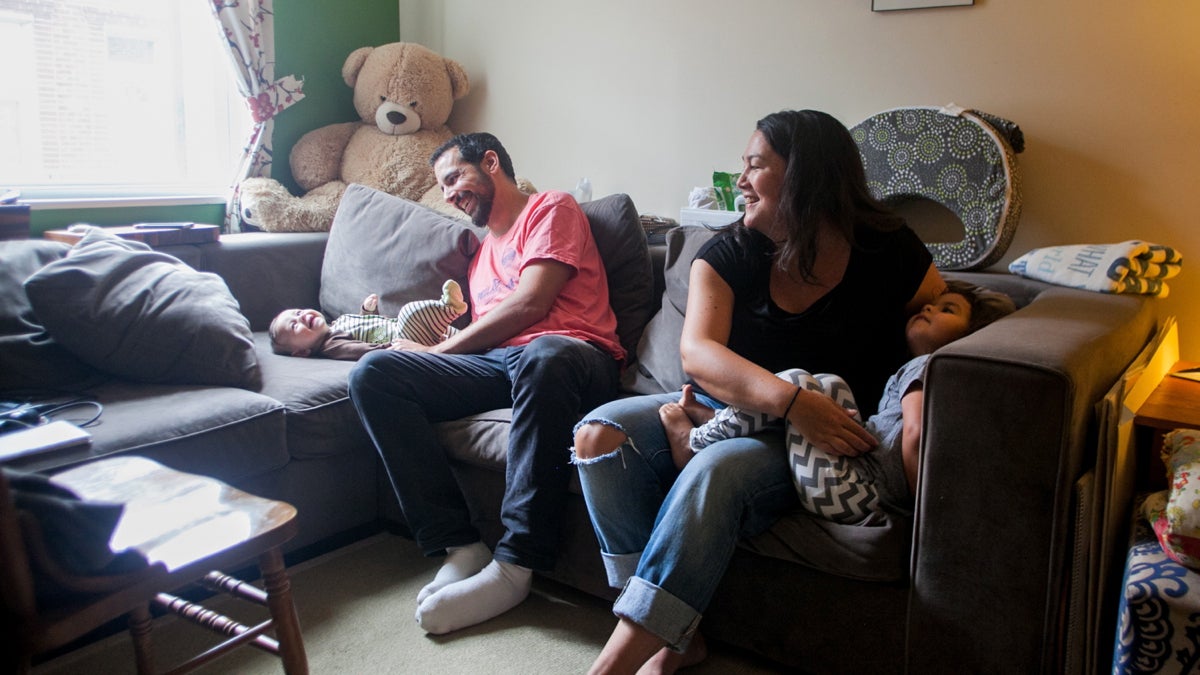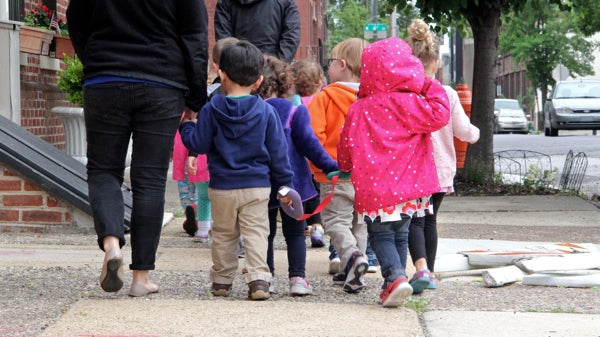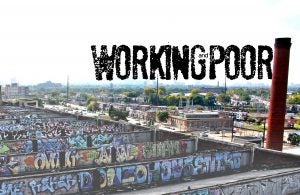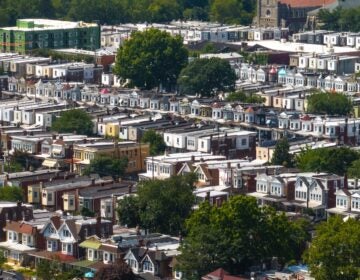Child care costs overshadow other necessities
"It's jaw-dropping," said Hunt. "We both have a college degree. We both have reasonably good jobs. I'm not doing something outrageous."
Listen 5:43
Jonathan Mosca and wife Michi Hunt play with their children, three-month-old Aiko and three-year-old Nori, in their South Philadelphia Home. (Brad Larrison for NewsWorks)
Nationwide, about 43 million people live below the federal poverty line. In Philadelphia and the surrounding suburbs, 800,000 people are struggling to make ends meet. In the weeks before November’s general election, we’ll examine how the policies put forth by our presidential candidates would affect them.
This is part two in a series, Working and Poor. Catch up on part one here.
—
Jon Mosca straddled the threshold of his South Philadelphia row home and stared down at his daughter Noriko. The 3-year-old was seated in her stroller at the foot of the stoop and showing no signs of cooperating.
“Want me to carry you?” said Mosca, while also chatting with his wife, Michiko Hunt, sitting in the living room with the couple’s other daughter, 4-month-old Aiko.
After a bit of prodding, Noriko trudged into the house, a slight scowl on her face.
Next step: Dinner. Tonight, it’s carrots and a yogurt for Noriko and, at some point, sausage and peppers for the adults.
“I really would love for us to have this moment where we all sit down, but it’s mostly getting [Noriko] fed and try to get her to bed and then we can eat. And this one, she can eat anytime,” said Hunt, referring to Aiko.
Besides, there are bigger fish to fry when it comes to raising their daughters, including paying for child care for both of them. It eats up nearly a third of their annual household income. The couple takes home just over $70,000 after taxes.
“It’s jaw-dropping,” said Hunt. “We both have a college degree. We both have reasonably good jobs. I’m not doing something outrageous.”
Noriko goes to day care — full time, five days a week. Aiko goes three.
That’s about $2,000 a month.
To pay for child care and everything else — the mortgage, groceries, clothes — Hunt and Mosca have taken on some credit card debt and pinch pennies day-to-day.
They’re not alone. In most counties in Pennsylvania, child care is the single biggest expense for families — more than rent and nearing or surpassing college tuition at a public university.
Median cost of child care by county for a family with one infant and one toddler
| County | Cost of care | Median income* | Percentage of income |
| Bucks | $24,061 | $110,464 | 22 % |
| Chester | $25,376 | $116,702 | 22 % |
| Delaware | $21,190 | $85,193 | 25 % |
| Montgomery | $25,220 | $106,759 | 24 % |
| Philadelphia | $21,320 | $36,893 | 58 %** |
*Median income for households with children under 18. **Families earning less than twice the poverty level ($48,500 for a family of four) receive federal subsidies for child care, so the median Philadelphia family would pay a lower percentage. (Source: Public Citizens for Children and Youth)
In Philadelphia and the surrounding suburbs, the average cost of child care for a preschooler and an infant is more than $23,000 a year.
“It’s at a breaking point here in Pennsylvania,” said Carol Austin, executive director of the Delaware Valley Association for the Education of Young Children, a child care advocacy group. “I dread to think we’ll just start warehousing kids.”
Candidates promise changes
But paying for child care could become easier when the next president takes office. In a somewhat surprising move, Donald Trump and Hillary Clinton both have proposals aimed at making child care more affordable, though using different methods.
Clinton wants to help parents by improving the country’s child care system.
Under her proposal, the cost of child care would be capped at 10 percent of a family’s income. For now, it’s unclear whether that applies to gross income or take-home pay.
For Hunt and Mosca, Clinton’s plan could save them anywhere from roughly $15,000 to $17,000 a year. They currently shell out $24,000.
“It would be amazing,” said Hunt of the potential decrease. “Even better would it to be free.”

Trump wants to give parents the ability to deduct the full amount of child care from their federal income taxes. That total can’t be more than the average cost of care in your state.
After getting some flack about not addressing poor families, his plan also includes an earned-income tax credit for low-income families who would not benefit as much from an income tax deduction for a simple reason: They don’t have a lot of income to taxed.
Hunt and Mosca wouldn’t qualify. Trump’s plan would bring down their annual child care costs just a few thousand dollars to $21,000.
Jamie Hopkins, a professor at the American College of Financial Services, said neither plan will make child care significantly cheaper for parents who are struggling to afford it now.
“That’s still going to be a burden whether these plans are in place or not. It might help ease some of that burden,” said Hopkins.
Hoping for some relief
His point rings especially true for low-income parents such as Stacey Booker, who lives in Ambler in Montgomery County with her 2-year-old daughter, Layah.
The single mother brings home roughly $1,400 a month after working two part-time jobs. One is at a senior home near her house. The other is at a rehab center in Norristown. Both call on her to be part housekeeper, part companion.
Booker technically lives above the poverty line, but not by much.
“It’s extremely hard. Sometimes, I’m surprised I don’t have a nervous breakdown or I’m not strung out on hardcore drugs or a severe alcoholic,” said Booker.
Child care for Layah is subsidized, but it still accounts for up to third of Booker’s monthly income depending on the time of year. She’s working toward a nursing degree, but school is out in the summer. She doesn’t get the subsidy on days she’s off work and school.
That happens more often then, but she said she has no choice — going without child care just isn’t an option. Not if she wants to build a better life.
“I have to pay for child care in order for my daughter to be in a school environment and for me to be able to go to work and go to school,” said Booker.
Experts say neither Trump nor Clinton’s child care plan would be cheap or easy to implement, at least according to the details out now.
Both are projected to cost billions.
Hopkins, the finance professor, said while both plans are expensive, they’re both realistic.
That has parents across the country feeling hopeful that their budgets could be a little less stressed, even if their days are still hectic.
WHYY is your source for fact-based, in-depth journalism and information. As a nonprofit organization, we rely on financial support from readers like you. Please give today.




